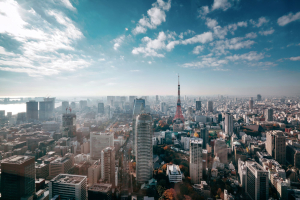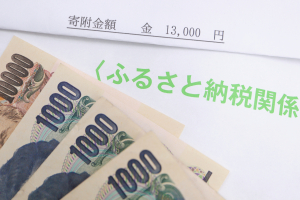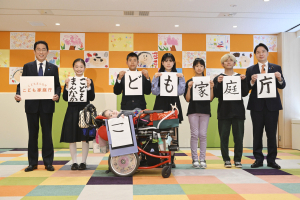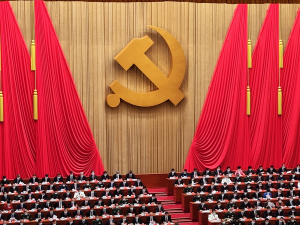
Can AI Alleviate Staffing Shortages in Japan’s Water Workforce?
February 21, 2022
R-2021-045E
The number of local government employees engaged in supplying drinking water has dwindled over the past several decades due to fiscal constraints and advances in digitization. Technological solutions are not enough to maintain this essential service, however, and there is an urgent need to develop the next generation of skilled workers.
* * *

Few people ever stop to think about the plumbers, technicians, and other workers who help to keep the water running through our taps. This year, 2022, will see the release of Kassui (Water Runs Dry), a movie adaptation of the novel of the same name by Mitsuru Kawabayashi, which won the Bungakukai Prize for New Writers in 1990 and was nominated for the prestigious Akutagawa Prize the same year. The film version features well-known actor Toma Ikuta in the main role as a waterworks bureau employee seeking payments from customers who have fallen behind on their bills. The story depicts the growing problems of poverty and neglect in contemporary society through the eyes of a man working on the frontlines of public services.
A reliable supply of safe drinking water has become so commonplace in our lives that we rarely stop to think of the people who work behind the scenes to make this possible, and most of us probably find it difficult to form a mental image of these people and the work they do.
The term “essential workers”—frequently used during the pandemic—describes people whose jobs are vital to the day-to-day functioning of modern society. Essential workers include people in healthcare, nursing and childcare, transport and logistics, retail, public infrastructure, food producers, and public servants providing government services.
People who work to maintain the physical infrastructure of daily life are also essential workers. This includes the technicians who work to supply us with electricity, gas, and communication services, as well as the waterworks employees who are the focus of this article. Collectively, this infrastructure forms the vital systems of society. It needs to be kept running constantly, day and night, and must be restored quickly if it is disrupted by a natural disaster or other emergency. These jobs are critical to keeping societies running, and also involve high levels of risk. Despite this, their importance is not widely recognized. This means that their importance to society is not reflected in better pay and working conditions, and as a result there is often a shortage of skilled workers in this field, despite the crucial role they play.
A Shrinking Workforce
The total number of people working at water supply facilities and related services (both local government workers and private-sector employees, not including temporary workers or workers in small-scale water supply systems) fell from 64,707 in 2005 to 53,356 in 2019—a decrease of 11,351, or 17.5%. The number employed in the public sector fell by 13,338 (22%) over this period, from 60,405 to 47,067, while the figure for the private sector rose by 1,987 (46.1%), from 4,302 to 6,289.[1]
This shift can be largely explained by a deliberate policy to reduce the number of people employed by local governments. Today, a combined total of approximately 2.8 million people are employed by prefectural and municipal governments. This represents a decline of 14.6% from the peak in 1994, when 3.28 million people worked as local civil servants. Staff reduction policies were eased in the second half of the 2010s, and the numbers have begun rising slightly in recent years.[2] The cuts took place mostly in the first decade of the 2000s, with the goal of narrowing fiscal deficits. Two main methods were employed to achieve this aim. The first was to reduce the scope of the services that local governments provide directly, and the second was to boost efficiency by introducing digital technology.
Table 1 shows how the number of people employed in various areas of the waterworks business has shifted since 2005.
Table 1. Number of Waterworks Employees by Occupation
Source: Compiled by the author based on Suido tokei: Shisetsu, gyomu-hen (Waterworks Statistics: Facilities and Operators), Japan Water Works Association, 2005, 2010, 2015–19.
“Engineers” (gijutsu shokuin) in the table above are responsible for designing and managing construction projects, such as the laying of pipes and building of waterworks facilities. “Technicians, etc.” (gino shokuin), on the other hand, fix leaking pipes and carry out other small-scale, physical maintenance work. In 2005, 6,707 people were employed in the latter category, but this number fell to 2,699 by 2019—a loss of 4,008 workers. Going back a little further, the 2019 figure represents a dramatic drop of nearly 80% from the 12,169 waterworks technicians in 1985.
Table 2 shows how these workers are distributed within the industry. In 2019, there were 881 water supply providers serving populations of up to 50,000 people. These organizations made up 67.5% of the total and employed just 6.9 people on average, with technical staff making up just a fraction of this number. Such smaller water providers operate with a small team of employees and subcontract much of their work to private companies. Until recently, one municipality had just one full-time employee, who had to call local plumbers and other private-sector specialists whenever problems arose. The worker was essentially a coordinator, whose job consisted of giving instructions to private-sector employees. I was told that the person had been unable to travel to other prefectures for the past eight years. Clearly, there are too few people being relegated the task of providing an essential service for the community.
Table 2. Average Number of Employees by Size of Water Supply Provider
Source: Compiled by the author based on Suido tokei Shisetsu gyomu-hen (Waterworks Statistics: Facilities and Providers), Japan Water Works Association, 2019.
The average age of waterworks employees was 44, and many were veterans aged 50 and over, with decades of experience in technology and management. Many of these employees will reach retirement age within the next few years. Should staff size shrink further due to attrition, maintaining water supply services could become quite difficult.
Problem of Aging Pipes
As I explained in Earthquake-Resilience Challenges for Japan’s Aging Waterworks, one major challenge for Japan is the problem of aging water pipes. In some areas, the same pipes have been in use for 50 or 60 years, with only small-scale, ad hoc improvements and repairs having been made over that time.[3] This means that regular inspections are essential. But in 2016, the Ministry of Health, Labor, and Welfare conducted a survey of nearly 6,000 water supply providers around the country that brought an alarming reality to light. Remarkably, fully 74% of providers were not carrying out periodic inspections of their pipes and other infrastructure.
Figure 1. Inspections of Waterworks Infrastructure
Source: Materials from the sixth meeting of the Committee to Promote the New Waterworks Vision (March 14, 2017).
In order to improve this situation, in 2018 revisions were made to the Water Supply Act, making water supply providers responsible for carrying out maintenance and improvements to facilities, including periodic inspections (Article 22.2), maintaining their ledgers in good order (Article 22.3), updating waterworks facilities in a planned manner from a long-term perspective, and drawing up and publishing for this purpose forecasts of income and expenditure, including costs required for modernization (Article 22.4). The Ministry of Health, Labor, and Welfare also issued additional guidance at this time, including the Guidelines on the Maintenance and Repairs of Waterworks Facilities.
In my interviews with various providers, however, operators often noted they were too busy with day-to-day work to have any time to carry out periodic inspections or maintain ledgers. Many told me that a smaller workforce meant that specialized skills were being lost. Even if the national government adopts policies designed to improve the upkeep of the nation’s waterworks systems, the truth is that there are no longer sufficient skilled people working on the frontlines to implement these policies.
Will Data Replace Human Workers?
The cuts in the number of local government employees in the 2000s were made possible by turning to digital technology to improve efficiency. This trend will continue, as increasing use is made in a wide range of industries and workplaces workstyles of innovations like cyber-physical systems (CPS) and the Internet of Things. A CPS combines a physical (real-world) system with various sensors, allowing the system to process and analyze information gathered by the sensors using digital technology. This is likely to prove useful in a wide range of industries, making possible objective analyses based on quantitative evidence rather than a worker’s experience or intuition.
The Internet of Things equips physical objects with sensors to transmit huge amounts of data via the Internet. Applications for CPS and IoT are likely to be introduced gradually in the waterworks industry to be used in such areas as predicting demand, water distribution planning, increasing production flexibility among water purification plants, real-time monitoring of water quality and volume, early detection of leaks, and identification of pipes in need of improvement. Eventually, the technology may even become an important tool for business management.
Even today, digitization is already helping to reduce the workload of human operators. Databases have been created for a wide variety of applications, providing information on water quality and volume at source, the operational status of various facilities, pipeline locations, and user numbers by region.
The first merit of digitization is the ability to monitor real-time information on facilities simply by looking at a computer or tablet. Even a new employee can ascertain conditions at various facilities and along waters pipe and have the same level of understanding as an employee with several years of experience. The same technology can be used to share information with workers from another provider who have come to give assistance following a natural disaster or other emergency, making it easier to provide backup supplies of water and restore the system.
The second merit is that it allows improvements on a day-to-day basis. Displaying data about all facilities across a network on a computer makes it possible to see how much water each purification plant produces per day, what share each facility contributes to total output, what the annual production costs are, and how much electricity each facility is consuming each year.
The third merit is that it is possible to plan improvements and renovations while simply looking at a computer screen. Eventually it will become possible to view all kinds of related data, including those on sewers, agricultural and industrial use water, electricity, gas, and other infrastructure. By combining this with weather information, it will become possible to get a comprehensive overview of the entire water cycle within a region.
But this will not do away with the need for a human presence to maintain and manage facilities. Plumbing and engineering robots may one day be able to mend water pipes, but this will take time. And it will take even longer for AI to replace humans in performing tasks that relate in complex ways to an irregular and unpredictable outside world. Human judgment is essential in responding to accidents in times of a disaster. AI may be ideal for making objective evaluations based on big data, but humans must decide how to act on such analyses. And for this reason, developing human workers who have an expert understanding of a region’s water situation will continue to be essential.
Responding to Climate Change
In recent years, a series of natural disasters have caused severe damage to waterworks facilities. Each time, technicians have worked around the clock to repair facilities as quickly as possible and restore people’s water supply.
Figure 2. Recent Natural Disasters and Number of Households Left without Water
Source: Compiled by the author based on sources from the Cabinet Office, Ministry of Health, Labor, and Welfare, Japan Water Works Association, and the city of Kurayoshi.[4]
In the past, efforts to safeguard the water supply infrastructure against natural disasters focused on improving seismic resistance. But over the past decade, there has been an increase in disruptions to the water supply caused by heavy rainfall. In 2018 the Ministry for Health, Labor, and Welfare carried out an inspection of critical waterworks facilities (water intake and conveyance facilities, water purification plants, and water storage and distribution facilities) of 1,355 water supply providers around the country.[5] The ministry learned that 2,745 facilities (14% of the total) were located in landslide warning areas, of which 2,577 (13%) were without any countermeasures. There were also 3,152 facilities (16%) located in potential submersion zones considered to be at high risk of flooding, of which 2,552 (13%) were without flood-protection measures. The Japan Meteorological Agency predicts that sudden rain showers will increase in the years to come as a result of climate change. Water providers therefore need to draw up comprehensive measures that consider the risk of landslides and flooding. But here, too, limited human resources and fiscal constraints make it difficult for utilities to respond adequately.
The workload of government employees is sometimes measured by comparing the number of government workers to the size the local population, but in the case of water supply services, the workload does not necessarily decrease when the local population declines. The same facilities and infrastructure must be maintained, and the burden on workers remains largely unchanged.
If we calculate the ratio of waterworks employees (both water supply and sewage) to the size of the population served by prefecture, the average number of people served per employee is 2,707. As Japan’s population declines, this number will also fall. If we calculate the same ratio based on infrastructure rather than population, however, using water pipes to represent facilities in general, we come up with a national average of 20.1 kilometers of pipeline for each employee. This figure is unaffected by population decline and will not improve even if local communities merge to form larger municipalities. This ratio is likely to rise as the number of workers falls in the years to come, moreover, further increasing the burden on already overworked employees.
Table 3. Population Supplied and Length of Pipeline per Employee
Ratio of Population to Waterworks Employees: Highest and Lowest Prefectures
Length of Pipeline to Waterworks Employees: Longest and Shortest Prefectures
Source: Compiled by the author based on Suido tokei: Shisetsu gyomu-hen (Waterworks Statistics: Facilities and Providers, Japan Water Works Association, 2019)
This means that the importance of human workers will not diminish even if AI is more widely introduced into waterworks services. It is for this reason that Article 5 of the Water Supply Act, in the section defining the basic policy for improving the nation’s water supply infrastructure, stipulates it is important for the prefectures and municipalities that operate water utilities to take a long-term perspective and ensure they are able to secure and train the human resources they will need.
The reality, though, is that while the number of new hires has increased somewhat among medium-sized and larger providers since 2000, no corresponding increase can be seen in smaller operators. And although the number of private-sector workers is increasing, there is a high turnover rate, meaning there has been little accumulation of experience or the passing-on of skills to the next generation. There are also problems with working conditions. According to the Rengo Wage Report 2021,[6] although wage levels in waterworks-related jobs (including public entities) were close to the average in 2020—scoring close to 100 on both the average wage level index and individual wage level index—wage hikes on both indices have been largely stagnant between 1997 to 2020.
The same report also contains information on the wage levels of public- and private-sector employees within the waterworks industry. Although the index for the industry as a whole is 105.1, the equivalent figures are 110.1 for the public sector and 92.7 for the private sector. These figures show that people hired by private companies are working at lower wages. The workers are playing a crucial role in supporting the industry, but priority is being given to profits, not the need to accumulate and pass on important skills. Tapping private-sector dynamism will do little to mitigate the fundamental problems confronting the industry.
Managing any business requires people, things, money, and information, and I have tried to address these issues in my two articles on this website. I have placed people first among the four factors because they are required to coordinate the other three. Information can play a useful role in helping human workers, but the work done by “essential workers” can often only be performed by human employees. Human judgment is essential in responding to accidents or a disaster. Likewise, it is the human urge to make the world a better place and to contribute to human happiness that drives people to harness their creativity and put their skills to work. They are the ones who will play a crucial role in securing the future of the nation’s water supply infrastructure in the years to come. They deserve greater credit for performing the work essential to keeping our society functioning smoothly.
[1] Suido tokei: Shisetsu, gyomu-hen (Waterworks Statistics: Facilities and Providers), Japan Water Works Association, 2005, 2010, 2015–19).
[2] Chiho kokyo dantai no so-shokuin-su no suii (Changes in Total Number of Employees Working for Local Government Organizations), Ministry of Internal Affairs website, accessed January 20, 2022, https://www.soumu.go.jp/main_content/000608426.pdf.
[3] Suido no genjo to kiban no kyoka ni tsuite (The Current Situation of Waterworks and Strengthening of Basic Infrastructure), website of the Ministry of Health, Labor, and Welfare, accessed January 12, 2022, https://www.gyoukaku.go.jp/review/aki/r01tokyo/img/s3_2.pdf.
[4] Kumamoto earthquake, “Kumamoto jishin ni okeru Nihon Suido Kyokai no taio ni tsuite” (On the Response of the Japan Water Works Association to the Kumamoto Earthquake), Japan Water Works Association, 2016, http://www.bousai.go.jp/kaigirep/tiho_juen/dai1kai/pdf/shiryo11.pdf.
Typhoon no. 10, 2016, “Heisei 28-nen taifu 10-go ni yoru higai jokyo-to ni tsuite” (On the State of Damage due to Typhoon No. 10, 2016), Cabinet Office, 2016, http://www.bousai.go.jp/updates/h28typhoon10/pdf/h28typhoon10_24.pdf.
Tottori earthquake, 2016, “Tottori-ken Chubu jishin saigai hokokusho” (Report on Damage Caused by the Earthquake in Central Tottori Prefecture), Kurayoshi City, 2016, https://www.city.kurayoshi.lg.jp/user/filer_public/29/a4/29a4e2e8-843f-46f2-9c46-b43b8e371f9d/161021report.pdf.
July 2017 torrential rains, Northern Kyushu, “Heisei 29-nen 7-gatsu Kyushu hokubu gou ni tsuite” (On the Torrential Rains in Northern Kyushu during July 2017), Ministry of Land, Infrastructure, Transport and Tourism, 2017, https://www.cbr.mlit.go.jp/mie/river/conference/ryuiki/pdf/19th/19th_shiryou-08.pdf.
Earthquake centered in northern Osaka Prefecture, “Osaka-fu hokubu o shingen to suru jishin higai anketo kekka ni tsuite” (On the Results of a Survey on Damage Caused by the Earthquake with Its Epicenter in Northern Osaka Prefecture), Japan Water Works Association, 2018.
Torrential rains, July 2018, “Heisei 30-nen (2018-nen) 7-gatsu gou suido shisetsu higai jokyo chosa hokokusho (Survey and Report on the State of Damage Caused to Waterworks Facilities by the Torrential Rains of July 2018), Ministry of Land, Infrastructure, Transport, and Tourism, Japan Water Works Association, 2021.
Typhoon no. 21, 2018, “Heisei 30-nen taifu 21-go ni kakaru higai jokyo-to ni tsuite (On the State of Damage Caused by Typhoon No. 21, 2018), Cabinet Office, 2019, http://www.bousai.go.jp/updates/h30typhoon21/pdf/300906_typhoon21_01.pdf.
2018 Hokkaido eastern Iburi earthquake, “Heisei 30-nen Hokkaido Iburi tobu jishin ni kakaru higai jokyo-to ni tsuite (On the State of Damage Caused by the 2018 Earthquake in Eastern Iburi, Hokkaido), Cabinet Office, 2019, http://www.bousai.go.jp/updates/h30jishin_hokkaido/pdf/310128_jishin_hokkaido.pdf.
Typhoon no. 15, 2019, “Reiwa gannen taifu 15-go ni kakaru higai jokyo-to ni tsuite (On the State of Damage Caused by Typhoon No. 15, 2019), Cabinet Office, 2020, http://www.bousai.go.jp/updates/r1typhoon15/pdf/r1typhoon15_30.pdf.
Typhoon no. 19, 2019, “Reiwa Gannen taifu 19-go ni kakaru higai jokyo-to ni tsuite (On the State of Damage Caused by Typhoon No. 19, 2019), Cabinet Office, 2020, http://www.bousai.go.jp/updates/r1typhoon19/pdf/r1typhoon19_45.pdf.
Torrential rains, July 2020, “Reiwa 2-nen 7-gatsu gou ni yoru higai jokyo-to ni tsuite” (On the State of Damage Caused by the Torrential Rains of July 2020), Cabinet Office, 2021, http://www.bousai.go.jp/updates/r2_07ooame/pdf/r20703_ooame_40.pdf.
Fukushima offshore earthquake, 2021, “Fukushima-ken oki o shingen to suru jishin ni kakaru higai jokyo-to ni tsuite” (On the State of Damage Caused by the Earthquake with its Epicenter Off the Shore of Fukushima Prefecture), Cabinet Office, 2021.
Torrential rains from July 1, 2021, “Reiwa 3-nen 7-gatsu tsuitachi kara no oame ni yoru higai jokyo-to ni tsuite” (On the State of Damage Caused by the Heavy Rains Starting July 1, 2021), Cabinet Office, 2021, http://www.bousai.go.jp/updates/r3_07ooame/pdf/r3_07ooame_17.pdf.
[5] “Suido ni okeru kinkyu tenken no kekka-to ni tsuite (joho kyoyu) (Regarding the Results of Urgent Inspections Carried Out on Waterworks Facilities [Shared Information]), Ministry of Health, Labor, and Welfare, December 14, 2018, https://www.mhlw.go.jp/content/10900000/000458928.pdf, accessed January 20, 2022.
[6] Rengo chingin repoto 2021 (Rengo Wage Report 2021), Japanese Trade Union Confederation-RENGO, https://www.jtuc-rengo.or.jp/activity/roudou/shuntou/index2022.html#document, accessed January 12, 2022.

![[Policy Research] Water Minfra: A New Strategy for Water-Centric Social Infrastructure](/files/research/2023/Oki_PG/Mizuminhura.png)







![[Policy Research] Water Minfra: A New Strategy for Water-Centric Social Infrastructure](/files_thumbnail/research_2023_Oki_PG_Mizuminhura_png_w300px_h180px.png)











































